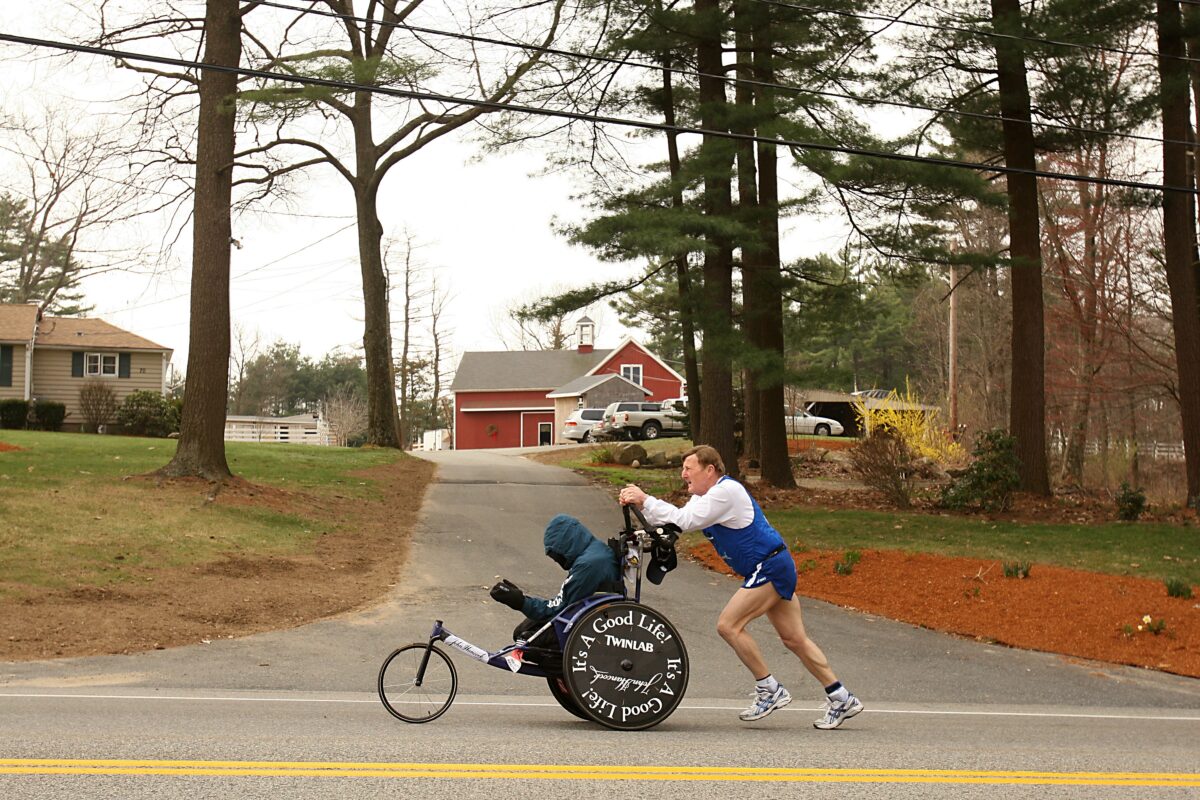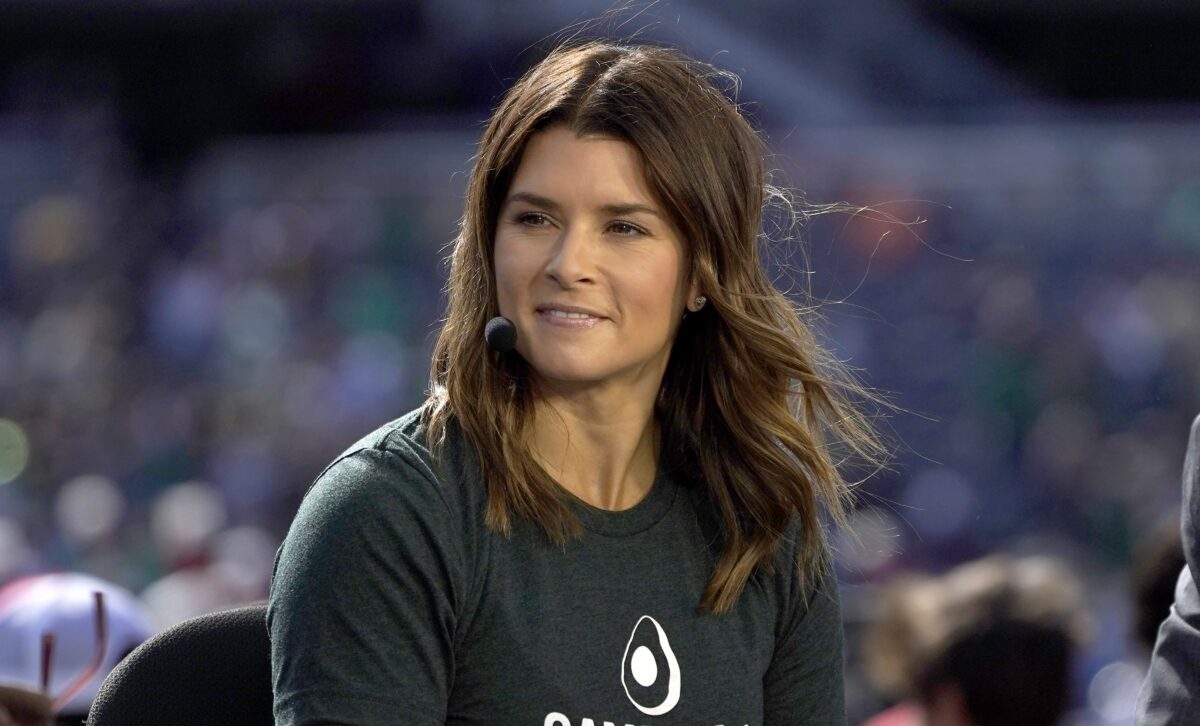Among the 20,000 Boston Marathon runners in this year’s race, Danica Patrick probably won’t stand out right away. But the number adorning her bib during Monday’s race might catch people’s attention, if they’re looking closely.
For her first 26.2-miler, Patrick will wear bib No. 500 in the prestigious marathon. Referencing her 14-year career at the highest levels of motor sports, the number is a nod to her achievements in the Indianapolis 500 and Daytona 500 from the Boston Athletic Association, the event organizer.
And when she crosses the finish line — she hopes near the four-hour mark — she’ll check off a lifelong goal.
“The only bucket list item I have is to run a marathon,” Patrick told For The Win recently.
“And I hope that it will be fun because the focuses have been train, be prepared, feel good, have fun.”
Since retiring from racing in NASCAR and IndyCar in 2018, Patrick has only slowed down in the literal sense. She’s been part of NBC’s Indy 500 broadcasts; last year, she launched Danica Rosé, sourced from Provence, France, and still has her Napa Valley-based wine brand, Somnium; and she hosts a weekly podcast called, Pretty Intense. And, of course, she’s still a fitness expert who regularly posts her workouts and motivational messages to her hundreds of thousands of Instagram followers.
But marathon training is totally different from something like CrossFit or a tough workout Patrick writes for herself. Luckily, she’s not doing it alone.
https://www.instagram.com/p/CUVxpBCleY1/
***
Patrick, 39, expects this to be her only marathon. And she’ll be joined by her “ride or die fitness crew” and two training partners: her sister, Brooke Selman, 37, and their friend, Erin Buntin, 43. They’re all fitness buffs who do CrossFit and push each other, and Monday, they’ll all run their first 26.2-miler together in the 125th Boston Marathon.
Typically, runners have to qualify for the Boston Marathon, so they’ve completed at least one 26.2-mile race before. But Patrick, Selman and Buntin are able to run Boston without qualifying because they’re running to support a charity, the Light Foundation, started by former New England Patriot Matt Light. Patrick is the honorary captain for Team Speed of Light. The three have collectively raised about $48,000, Buntin said.
https://www.instagram.com/p/CSAJtshHQRS/
“When you’re like, ‘I’m running Boston,’ [people are] like, ‘Oh, where do you qualify?’ And they almost discredit you a little bit,” Selman said. “And I’m like, screw that. … What we’re doing is really neat because we’re running with a purpose.”
The trio have been training for the Boston Marathon since about Memorial Day, but most of the time, they’re not physically together with Patrick based in Scottsdale, Selman in Indianapolis and Buntin in Green Bay.
All three agreed Patrick is the most natural runner among them, and the retired race car driver said that goes back to when she was growing up and would run with her mom early in the mornings — even in the winters. She said while running long distances isn’t part of her typical workout routines, it always feels comfortable and familiar.
In part because of that, Patrick said she went into her marathon training confident. Perhaps too confident, as she focused more on the longer runs than the shorter ones in between. So “as the mileage got cranking,” there was a bit of a reality check.
“[Arizona] has been so nuclear hot,” Patrick said about her training this summer. “And so I think my 16- and 18-mile runs really made me realize, ‘Holy crap, I better dial this in because I feel terrible right now.'”
So she adjusted her training and focus. But she said because “the nature of the sport is really hard on the body” — and in very different way than NASCAR and IndyCar were — she’s gained a greater perspective about the importance of recovery, like dry needling, and refueling. From electrolytes and sodium to energy gel products recommended by Selman, Patrick said she’s learned how to sustain her body properly for a feat like the marathon.
And as she ran from wherever her schedule allowed — like desert training at home in Arizona and “punishing” altitude runs in Telluride, Colorado — hydration has been everything.
https://www.instagram.com/p/CRwqzzPnF3T/
Patrick noted she’s also learned to play the “mental game” of distance running. Thinking about what hurts and what feels good during a long run, the mind games she plays with herself help her push past the pain — or, as she recently wrote on Instagram, when “[expletive] gets real after about 12” miles.
“‘I’m gonna take a UCAN Edge [energy gel] at mile 14, I just gotta get to mile 14,'” Patrick said she tells herself.
“‘OK, I know every mile, I’m going to take a big drink of my electrolytes. That’s gonna feel really good.’ And so you just start making mini goals. But the body is really giving you the big middle finger, saying, ‘This hurts. This is hard. I’m dehydrated.'”
And if Patrick, Selman or Buntin need help or an extra push, there’s a group chat for that. Patrick said she and Buntin — who met at a CrossFit gym in Green Bay a few years ago — have built a “strong foundation” for their friendship rooted in working out, which quickly included Selman.
“We talk every single day about either how your runs are going or fueling,” Selman said. “What are you doing and drinking and hydration and all that stuff. We are constantly talking, and it is a topic that we talk about literally every day.”
***
Although the three soon-to-be marathoners live in different cities across the country, they’ve still found a handful of times to run together, like they will in Boston. Buntin said she and Selman ran together in Madison this summer, and more recently, Patrick and Buntin completed their final long training run, a 16-miler, in Chicago early last week and have since been in taper mode.
But as a group, the only time the three of them have trained for the marathon together was their longest training run, a 20-miler in Napa in September. And they treated it — like they have been with several of their longer runs — as a dress rehearsal for Boston, wearing the same clothes they intend to wear on race day down to the socks and coming prepared with supplies to limit chafing or blisters.
https://www.instagram.com/p/CT6RCOEFniN/
“This whole thing has really proven to be a growth for us mentally, physically, emotionally [and], I would say, even spiritually,” Buntin said. “And so those are the motivations, right? So if somebody is in a mental block or has a [expletive] run, you have two people going, ‘We’ll break it down,’ and, ‘What were your shining moments in it?’ Or ‘[Where] physically you’re having a hard time?'”
For some people attempting a marathon for the first time, the goal can simply be to finish. As a self-described “non-runner,” Buntin’s goals for Boston were more focused on having a strong training program and enjoying it and being injury-free on race day. Selman is aiming to have the kind of race where she feels good — or as good as one could expect — by the end.
For Patrick, as she was building up her mileage early on in training, she was running about 8:15-minute miles and initially thought an 8:40 pace for Boston would be attainable. But after learning more about her body through training, plus weather potentially playing a role, she and her group have a more realistic goal of a four-hour marathon – or a little higher than a nine-minute mile pace.
But Patrick outlined tiers of goals for her first marathon, ranging from breaking four hours to a 9:30-minute mile pace to finishing the race. And running and staying together through all 26.2 miles will “make a really big difference,” she said.
“It will help be really distracting to just be running with your friends and being able to run together,” Patrick said. “It’s like, y’all just kind of pull each other along.
“And it’s supposed to be fun! I’m not going to set some world record. I’m not going to go win the race; that’s not going to happen. And so the point is that it’s something that I wanted to do.”
Still, the Boston Marathon course is a daunting one that includes the infamous Heartbreak Hill — the final in a series of hills with a steep half-mile incline at mile 20 when runners’ legs are anything but fresh. But Patrick renamed it, Buntin said, to something more positive because once the hill is completed, there are only about six miles left.
“We felt like the name Heartbreak Hill had such a fearful word tied to it that we’ve actually referred to as Home Free Hill,” Buntin said. “Because once we get beyond that, we are literally home free.”
[mm-video type=video id=01fh5yhscm5a6g8y4h6c playlist_id=none player_id=01evcfkb10bw5a3nky image=https://images2.minutemediacdn.com/image/upload/video/thumbnail/mmplus/01fh5yhscm5a6g8y4h6c/01fh5yhscm5a6g8y4h6c-1be189da533619980cd1bda2fcfdd11a.jpg]
[lawrence-related id=949933,911801,898316]








